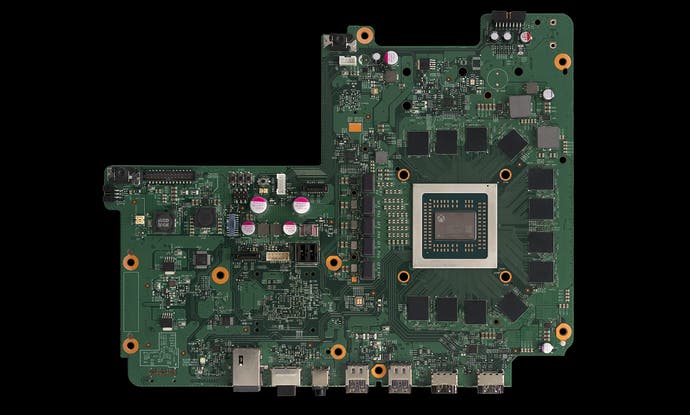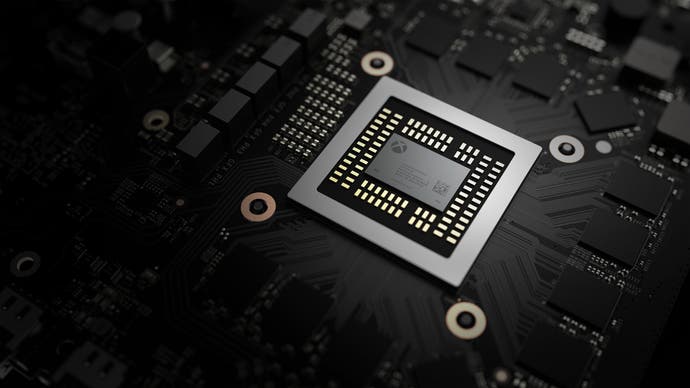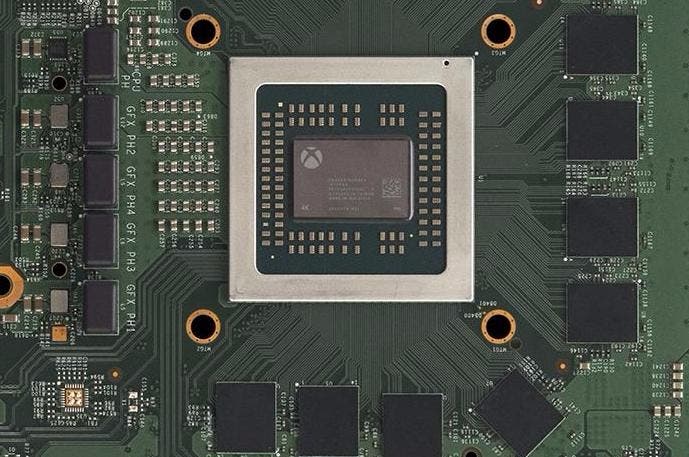Scorpio is console hardware pushed to a new level
Opinion and analysis from Digital Foundry's Rich Leadbetter.
In 2005, Microsoft launched Xbox 360: a piece of hardware at least a year ahead of its time from a technological standpoint, introducing multi-core CPU processing and state-of-the-art advanced graphics technology. PlayStation 3 arrived a year later - an absolute age in technological terms - but the Xbox 360 still shone through. It was the product of a company determined to do everything it could to create the most powerful games console ever made. After the media missteps of Xbox One and the loss of performance leadership, Project Scorpio is a return to that fierce determination to produce the best possible box. This is the result of an Xbox team with something to prove - exactly the reaction we hoped for.
Microsoft's invitation to Digital Foundry to talk tech and exclusively reveal specs is a bold, brave move that at once highlights the platform holder's confidence in its new hardware, and continues its strategy of keeping users informed well ahead of time, as opposed to seeing carefully laid plans exposed via a relentless, inevitable trickle of leaks. The tactic worked at E3 (albeit at the cost of annoying some Xbox One owners, and gazumping the announcement of Xbox One S), and it continues to pay off with this reveal.
Across one extremely packed day just over a week ago at Microsoft's vast Redmond campus, I met with silicon architects, hardware designers, corporate vice presidents and P3 himself: head of Xbox, Phil Spencer. I can't think of any example of access at this level so far in advance of the launch of new hardware, but fundamentally, Project Scorpio is aimed at a very different user to prospective Xbox One S owners, making this coverage potentially less impactful to sales of the existing device. These days, Xbox One has skewed towards value, while Scorpio will be a piece of hardware with a premium price-point. My sense is that the price differential will be fairly wide and that there'll be less crossover in the audience than there is with PS4 and Pro.
Coming out of my visit and talking to colleagues, the main questions I was asked mainly concerned things that either I can't talk about or don't know. What does it look like? How big is it? What are the games like? What's it called and how much will it cost? On the latter point, we can at least have some informed speculation. PS4 Pro launched at £349/$399. Scorpio has a larger processor (the most expensive single part of any console), 4GB more memory, a faster hard drive, a UHD Blu-ray drive and a state-of-the-art cooling solution. All of these add cumulatively to the bill of materials and if I had to guess - and I'll stress that this isn't based on anything I might have heard on my visit - Project Scorpio is going to cost in the region of $499.
What's it going to be called? Again, there are no hints here from anyone at Microsoft, except to say that there's lots of talk about Scorpio being a part of 'the Xbox One family of products', so I wouldn't be surprised to see the machine named appropriately. The core concept is that Scorpio sits alongside Xbox One offering the same games, the same fundamental gameplay, separated not just by 1080p and 4K display ownership, but also by how committed the users are to owning the latest and greatest technology. Compared to last year though, the messaging to 1080p users - and indeed the delivery of features - is more firmly defined, an area where Microsoft has also learned from Sony's missteps with PS4 Pro.
Project Scorpio vs PS4 Pro: the spec differential
Despite the scale of today's reveal, we don't actually know that much more about the ways in which multi-platform software will vary between Project Scorpio and PlayStation 4 Pro. We went in knowing about a six-teraflop GPU and a huge boost to memory bandwidth and that's exactly what Microsoft has delivered. We guessed right on the 12GB of GDDR5 (fairly clearly signposted in the original E3 reveal), and this means that Scorpio versions will benefit from higher resolution textures where they are available. Where we got it wrong was in the make-up of the GPU. We predicted a slower but wider GPU to get to six teraflops. Instead, Microsoft has defied current-gen constraints and redefined the way consoles are built in order to push clock-speeds up closer to desktop GPU counterparts - a brilliant achievement.
As a result, at a base level, we anticipate third party releases where Scorpio enjoys higher resolutions and more detailed art, but the scale of the difference is something we can't draw definitive conclusions on until we start to see games. The best case scenario for Microsoft is that its CPU and GPU hardware customisation - derived directly from granular analysis of existing game engines - will produce a gulf in results even wider than those seen frequently seen in Xbox One/PS4 cross-platform releases.
If we take Microsoft's statements at face value, there's no reason why all titles that run at 1080p on Xbox One shouldn't run at native 4K - and the Forza Motorsport demo I saw presents some compelling evidence to support this. But it's perhaps the 900p third-party games (where base PS4 typically hits full 1080p) that will be more illuminating. Microsoft says that while the porting work will be more involved, these too should hit native 4K. However, just like PS4 Pro, the GPU has hardware support for checkerboarding and other pixel-efficient techniques, which Microsoft expects to see rolled out on the small amount of games on Xbox One that drop beneath 900p.
The big question is this: factoring out higher resolution art (which will undoubtedly make a difference) will we be able to tell the difference between Scorpio and Pro games? Results vary according to content of course, but what PS4 Pro has proved is that checkerboarding, advanced anti-aliasing techniques, temporal super-sampling and dynamic resolution go a long way in closing the gap between sub-native ultra HD resolutions and the true 4K experience Microsoft is aiming for. However, on the flipside, it's not been a complete success by any means: Pro has handed in a few too many straight 1440p releases while actual, barnstorming, first-party 2160p HDR showcases have been few and far between. At the very least, variance will be down to resolution and frame-rate only - a 4K re-run of the current-gen Xbox One/PS4 Face-Offs - but this time in Microsoft's favour. Don't underestimate the importance of the additional memory, though. 4K textures already make a noticeable difference on titles like Rise of the Tomb Raider, even if you run the ultra HD mode at 1080p.

Project Scorpio vs PC: to-the-metal design vs sheer brute force
The closest equivalent to PlayStation 4 Pro's GPU in the PC space, in pure performance terms, is the Radeon RX 470 or an underclocked RX 480 - both mainstream graphics cards. The latter product typically overclocks to hit the same six-teraflop compute output as Project Scorpio. However, teraflop comparisons here simply do not reflect real-world results. With one or two exceptions, the 'next-gen' upscaling techniques used on PS4 Pro don't tend to exist in the PC space - and software-level PC upscalers that can produce great results still only manifest in a minority of games. On both counts, we expect things to change rapidly, but the bottom line is that right now, consoles are capable of producing some great 4K results even if the technical sleight of hand required to get there means that it's not strictly speaking a 'proper' native ultra HD resolution. This means more bang for your buck from your console purchase.
The bottom line is that Scorpio's six teraflops will almost certainly go a lot further than an equivalent PC part. I asked Microsoft about this specifically, and they raise a number of good arguments that make the case strongly. Firstly, that their shader compiler is far more efficient than PC equivalents (think of shaders as native GPU code). Secondly, addressing the hardware directly via their API and with access to console-specific GPU extensions again adds to the advantage of a fixed platform box. And finally, they point to their optimisation software - PIX (Performance Investigator for Xbox) - as a tool that provides the path to console-specific optimisations that PC simply cannot get.
From what I've seen so far, there is some evidence that Scorpio's true 4K performance could pose a challenge to the likes of Nvidia's GTX 1070 and AMD's Fury X-class hardware. I've seen Microsoft's new console running a Forza Motorsport 6-level experience locked to 4K60 on the equivalent to PC's ultra settings - cranking up the quality presets to obscene levels was one of the first things developer Turn 10 did when confronted with the sheer amount of headroom it had left after a straight Xbox One port. Out of interest, we tested Forza 6 Apex with similar settings at 4K on GTX 1060, 1070 and 1080. Frames were dropped on GTX 1060 (and a lot of them when wet weather conditions kicked in), while GTX 1070 held firm with only the most intense wet weather conditions causing performance dips. Only GTX 1080 held completely solid in all test cases. It's only one data point, and the extent to which the code is comparable at all is debatable, but it certainly doesn't harm Scorpio's credentials: Forza 6 Apex received plenty of praise for the quality of its PC port.
The bottom line: PC games need to evolve to more efficiently address 4K, in order to bring down the cost of GPU hardware to effectively and consistently power an ultra HD screen with the latest games. The best console titles have led the way here, and it's a tradition we expect to see continue on Project Scorpio. If third-party games live up to the first-party results we have seen, where 900p and 1080p games scale up to native 4K, the comparisons with PC hardware will prove absolutely fascinating. If Scorpio's GPU can hold native 4K and hand in results on par or better than GTX 1070, this is a seriously good result for a console.

Scorpio's four pillars and a renewed 1080p focus
Before the hardware deep dives commenced, Mike Ybarra, Corporate Vice-President of the Xbox and Windows Gaming Platform dropped by to outline what he called the 'four pillars' behind Scorpio: regaining the hearts and minds of developers, delivering enough power to hand in a great 'true 4K' experience, providing complete compatibility with existing hardware and software (and running old games better) and - crucially - making sure that Scorpio can 'light up' 1080p TVs.
To be clear, Microsoft still expects to sell more Xbox One consoles than Scorpio boxes, and the older tech is perhaps a better fit for full HD displays, but the platform holder has clearly looked at PlayStation 4 Pro take-up - very strong with existing 1080p screen users - and decided that a shift in strategy is required. Last year at E3, Xbox boss Phil Spencer positioned Scorpio very much as a 4K-focused console, though later comments balanced out the pros and cons more effectively for those hanging on to the existing displays. It's the right move, as I believe that core gamers are more likely to upgrade their consoles than their displays, in the short term at least.
With some PS4 Pro titles, we've been vocal in our criticisms of game modes locked to specific display types. If a title has a high resolution mode, 1080p display users should get super-sampling - something that doesn't always happen, even on Sony first party games. Part of Microsoft's commitment to the 1080p user is that super-sampling just happens out of the box - if a Scorpio title runs at a higher rendering resolution, it must downsample for full HD screens. Similarly, in-game frame-rates must be the same or faster than standard Xbox One titles. Hopefully we'll actually see smoother performance. [UPDATE: We've updated this paragraph to clarify that downsampling happens at a system level, it's not a requirement for the developer to implement it.]
At the hardware level, Microsoft is confident in the quality of the scaler built into Scorpio's display processor. It's enhanced over the Xbox One S equivalent to "handle the bandwidth and quality requirements of 4K", using a high quality six-tap vertical and horizontal Lanczos filter. Compared to a native 1080p output on Xbox One, super-sampling is a great feature to have: anti-aliasing quality is second to none, the same texture filtering quality improves with more resolution (for a given screen area, the texture is sampled more) and art is richer owing to the use of more highly detailed texture assets.
Microsoft's insistence on 1080p supersampling is actually more inclusive than it sounds, and it's good news for users of all screens. There have been instances of PS4 Pro games with higher performance 1080p modes only accessible if the front-end is set to a full HD output - No Man's Sky and The Last Guardian are two examples of this. If your Pro's set to 4K instead, you might never even know that an alternative, higher performing mode exists. With Scorpio, all game modes - resolution, performance or otherwise - must be available to all users regardless of the display the console is attached to. This philosophy reflects a long-held Digital Foundry view, and hopefully PS4 Pro titles will also follow suit.
Is this the end of the traditional console generation?
This is where we suspect there is a difference in opinion between Sony and Microsoft. Last year, Mark Cerny drew a line in the sand - PS4 and Pro were of the same generation and we'd require a radical upgrade in CPU, GPU, memory and storage to justify a prospective PlayStation 5. Mike Ybarra's comments about users wanting the latest technology faster suggest something different.
Our take? Mark Cerny's outlook is possibly the ideal, and more in line with the core gamer's expectations, but Mike Ybarra hinting at more frequent console refreshes more closely fits the realities of console manufacturing. Moore's Law is slowing down. A 6x to 8x leap in console power every five years is looking less and less viable, so we should expect to see more frequent, more iterative upgrades. However, likening this to a mobile phone upgrade cycle isn't the way I see things going. A new console with a 2x-3x boost every three to four years seems more likely, based on current trends.
Typically, two aspects define improvements in console power - innovative design and the ability to shrink transistors down using the latest semiconductor fabrication technologies. By my reckoning, there's plenty of scope to see performance improvements via the former, but the latter is going to be a struggle. PS4 and Xbox One launched in 2013 and used 28nm chip fabrication technology - first used on PC graphics cards way back in 2011. The replacement 16nm FinFET process used on both Pro and Scorpio only became viable five years later - and I'd venture to suggest that both consoles would not be viable without it. 10nm is starting to roll out now, but may not be suitable for consoles, while 7nm is some years away. With that in mind, more iterative console launches may be the only way to get better hardware out to tech-hungry gamers, but even so, yearly or biannual updates are highly unlikely.
The fortunes of the mid-generation refresh in the longer term remain to be seen, but in the here and now, the transition to 4K display technology is certainly a good enough reason to bring devices like Scorpio and Pro to the market. The transition to ultra HD TVs is the best chance Microsoft will have to launch a more frequent console upgrade cycle. For those wavering over a purchase this year, perhaps not fully convinced by 4K, I'd urge you to check out Horizon Zero Dawn running in HDR on a 4K LG OLED display, or Sony's own ZD9. It's a first-party tech showcase par excellence operating on the best screens available now, and it looks incredible.
In the wake of the Microsoft visit, I've little doubt that Project Scorpio will be a great piece of hardware. Xbox One S went above and beyond what we would expect from a second-gen 'slim' design - in a sense, the Xbox team regained its hardware mojo. But the technology, craftsmanship and attention to detail throughout the new device is simply first class (the only unknown remaining from my perspective is fan noise). It's entirely fair to say that with Xbox One, Microsoft lost technological leadership to Sony and PlayStation 4. Project Scorpio really is exactly the right reaction from the Xbox team in the face of Sony's success: in many respects, this is console hardware design pushed to a new level, with a meticulous focus on appealing to the core gamer.
Beyond that, the excruciating wait begins to see what Scorpio can do where it really counts: its games need to deliver to the same level as its hardware.
We learned about Project Scorpio at an exclusive briefing at Xbox HQ. Microsoft paid for travel and accommodation.



